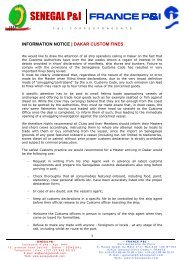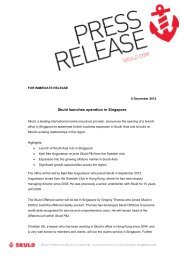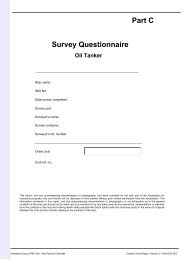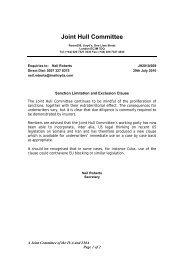Complete PDF version - Skuld
Complete PDF version - Skuld
Complete PDF version - Skuld
You also want an ePaper? Increase the reach of your titles
YUMPU automatically turns print PDFs into web optimized ePapers that Google loves.
LEGALISSUESBy Jonathan HareSenior Vice President CounselMaritime Law & International Group, <strong>Skuld</strong>jonathan.hare@skuld.comA LOOK AT THE IMO CONVENTIONSCOMPULSORYINSURANCEThe need for Certificates as a consequence of the entry into force ofthe Bunkers Convention has created an additional workload for P&IClubs and members. But what are the Certificates for and what arethe implications for club exposure?INCREASED EXPOSUREMany members will be aware ofthe Bunkers Convention for onereason only, namely because theyneed to add the Bunkers ConventionCertificate to the long list ofdocuments which their ships mustcarry on board. However, lookingbeyond the paperwork, the entryinto force of the Convention marksa fundamental shift in the way inwhich P&I clubs operate.The purpose of the Conventionis to protect claimants who sufferpollution damage caused bybunker spills. The Certificateconfirms that the P&I Club namedin it accepts that claimants cansue the club direct and that theclub will be responsible for theshipowners’ liability for pollutiondamage.The club cannot refuse to payon the ground that the owner isin breach of his terms of coverbecause, for example, premiumsare not paid or the vessel is out ofclass. The club can only rely onone rarely used policy defence,that of wilful misconduct.MORE THAN 30,000 CERTIFICATESThis is nothing new in the sensethat this legal regime has appliedto oil tankers since 1975. However,the Bunkers Convention is still asignificant development. It is thefirst time that the industry as awhole outside of the tanker sectorhas been subject to the compulsoryinsurance regime of an IMOConvention.Although tankers are of coursea key part of any Club’s portfolio,they make up a relatively smallproportion of the world fleet. Incontrast, the number of shipswhich will require Bunkers Certificatesin the run up to 20 Februaryeach year is well in excess of30,000.MORE TO COMEThere is also more to come.There are three more IMO Conventionsin the pipeline whichhave the same insurance andcertification requirements (seeinformation on right). While theAthens Convention will only applyto passenger ships, it remains ofinterest to the entire industry inview of the potential reinsuranceimplications in the event of a majorincident. The remaining two will,like the Bunkers Convention,apply to a broad cross-sectionof ships.WHAT ARE CLUBS FOR?The system imposed by governmentsthrough the IMO meansthat claimants’ prospects ofrecovery are unaffected by theshipowners’ conduct or solvency.Clubs are in effect becomingguarantors. The clubs’ liabilitytowards the claimant dependsnot on the club Rules but on theprovisions in the Convention.This is far removed from thecomfortable days of the pay tobe paid rule when club existedto reimburse members and remainedlargely invisible to theoutside world. Clubs continueto protect and indemnify theirmembers but they are now alsorequired to fulfil a much broadersocial function and accept directresponsibility towards membersof the public who are affected bymarine pollution.IMO CONVENTIONS IN FORCECIVIL LIABILITY CONVENTION:Oil pollution from tankersBUNKERS CONVENTION:Pollution caused by bunkersIMO CONVENTIONS NOT YET IN FORCEHAZARDOUS & NOXIOUSSUBSTANCES (HNS):Damage caused by dangerous cargoesWRECK:Wreck removal costsATHENS CONVENTION:Passenger injury & deathREAD MOREwww.skuld.com“THECONVENTIONMARKS AFUNDAMENTALSHIFT IN THEWAY IN WHICHP&I CLUBSOPERATE”16 BEACON / DECEMBER 2008
















